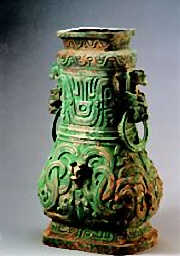4) Two bronze vessels bear inscriptions of the year, month, "heavenly stems" and "earthly branches" (two sets of signs combined to make 60 pairs to designate the year, month and day), phases of the moon (used by ancient people to record dates), and the year of casting (the 42nd and 43rd year of the reign of a certain king). It was common practice to record the year of the casting but not the name of the king. The vessels thus provide rare reference material for research into the Western Zhou calendar.
5) Chinese epigraphic experts have identified a record 4,048 characters on the 27 bronze pieces, which sets a new record among historic findings where a single clan had produced such an extensive written record.
6) Historical data gives a clear description of the Shan clan that enjoyed a high status during the Zhou Dynasty. However, over the past several thousand years, archeologists have consistently failed to establish a specific time or place for the clan's origin.
 The inscriptions on the two bronze vessels clearly indicate that the ancestor of the Shan clan was a Duke of Shan who had served as a minister to Kings Wen and Wu (about 1100BC) of the Zhou Dynasty. The owner of these vessels was of the eighth generation of the Shan clan and was an official in charge of forestry and a military officer in the war against barbarian aggression during the Western Zhou Dynasty. The inscriptions also document the laurels awarded to the Shan clan, as well as records of outstanding achievements among the Zhou kings -- from King Wen to King Xiao -- which are very valuable to researching the history of the Shan clan and the relations between the Zhou Dynasty and its surrounding northwestern tribes.
The inscriptions on the two bronze vessels clearly indicate that the ancestor of the Shan clan was a Duke of Shan who had served as a minister to Kings Wen and Wu (about 1100BC) of the Zhou Dynasty. The owner of these vessels was of the eighth generation of the Shan clan and was an official in charge of forestry and a military officer in the war against barbarian aggression during the Western Zhou Dynasty. The inscriptions also document the laurels awarded to the Shan clan, as well as records of outstanding achievements among the Zhou kings -- from King Wen to King Xiao -- which are very valuable to researching the history of the Shan clan and the relations between the Zhou Dynasty and its surrounding northwestern tribes.
 Significance
Significance
The inscriptions not only provide valuable research material into the history and culture of the Western Zhou but also help date the Xia to about 2100-1600BC); the Shang, about 1600-1100BC; and the Zhou, about 1100-221BC.
It is hoped the inscriptions will help resolve some of the numerous mysteries surrounding the history of the Western Zhou Dynasty, which was the most important period for the Chinese nation in its rise to prosperity. These relics are of high academic value for the study of the politics, economy and culture of the Zhou Dynasty. The well-written inscriptions give a clear account of the history of the dynasty, which will help historians gain a better understanding of ancient China's civilization.
This was the fifth time that such important bronze artifacts have been unearthed in Yangjia since 1949, bringing the small village into the spotlight once again. The bronze ware discovered in Yang village comprise another important finding following the excavations in Qishan in 1975 and Fufeng in 1976. The fact that the three venues are all located in Baoji city suggests that there is actually a large number of ancient bronze ware buried there. Baoji also boasts the only bronze ware museum in all of China.
